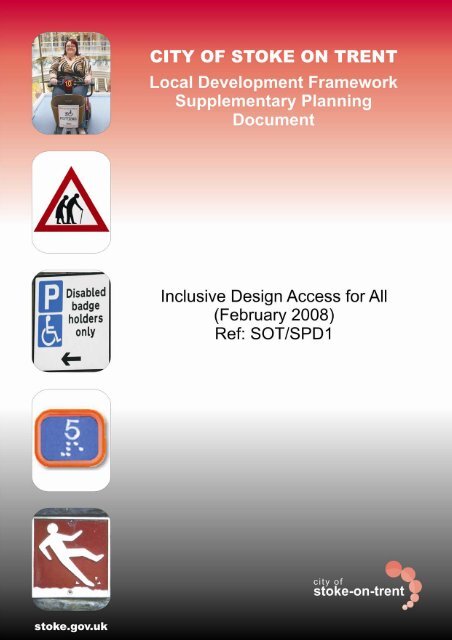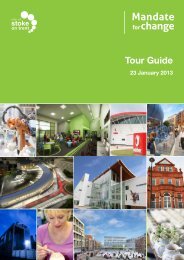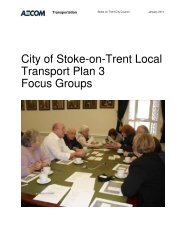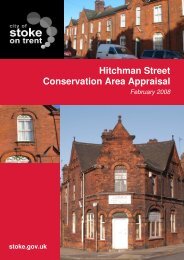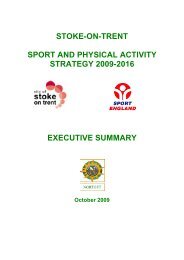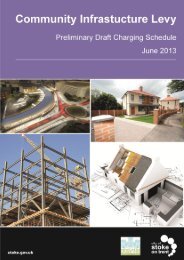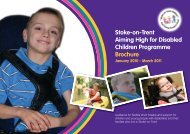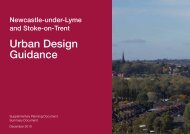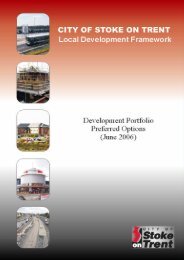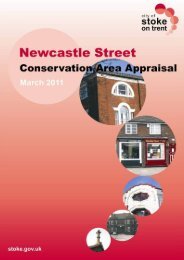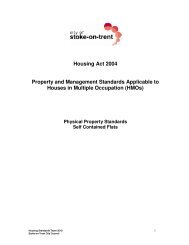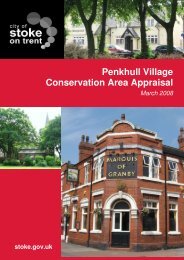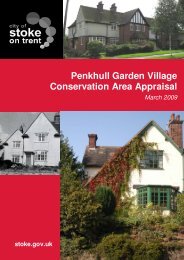Draft Supplementary Planning Guidance - Stoke-on-Trent City Council
Draft Supplementary Planning Guidance - Stoke-on-Trent City Council
Draft Supplementary Planning Guidance - Stoke-on-Trent City Council
You also want an ePaper? Increase the reach of your titles
YUMPU automatically turns print PDFs into web optimized ePapers that Google loves.
<str<strong>on</strong>g>Supplementary</str<strong>on</strong>g> <str<strong>on</strong>g>Planning</str<strong>on</strong>g> Document<br />
Inclusive Design<br />
Access For All<br />
February 2008<br />
(SOT/SPD1)<br />
<str<strong>on</strong>g>Stoke</str<strong>on</strong>g>-<strong>on</strong>-<strong>Trent</strong> <strong>City</strong> <strong>Council</strong>
C<strong>on</strong>tents<br />
Introducti<strong>on</strong> and Background 5<br />
Purpose and Role of the SPD 5<br />
<str<strong>on</strong>g>Planning</str<strong>on</strong>g> Policy C<strong>on</strong>text 6<br />
Sustainability Appraisal 6<br />
Inclusive Design 7<br />
Disability Discriminati<strong>on</strong> Act 8<br />
Design and Access Statements 8<br />
C<strong>on</strong>sultati<strong>on</strong> 9<br />
Updates 9<br />
<str<strong>on</strong>g>Guidance</str<strong>on</strong>g> – Space Requirements 10<br />
Dwellings 12<br />
Off-Street Parking 14<br />
On-Street Parking 17<br />
Accessible Setting Down Areas 17<br />
Visitor Parking in Residential Areas 18<br />
Accessible Bus / Taxi Stops 19<br />
Accessible Approach Paths and Access Routes 20<br />
Footbridges and Underpasses 23<br />
Pedestrianised Areas 23<br />
Pedestrian Advantage 23<br />
Tactile Surfaces 24<br />
Street Furniture, Barriers, Restricti<strong>on</strong>s and Hazards 25<br />
Cycle Parking 27<br />
Automatic Telling Machines (ATMs) 29<br />
3
Smoking Shelters 29<br />
Signage and Wayfinding 30<br />
Ramped Access 32<br />
Stepped Access 34<br />
Handrails to Steps and Ramps 35<br />
Accessible Entrances 37<br />
Glazing in Public Spaces 39<br />
Shop Fr<strong>on</strong>ts 39<br />
Access Lifts 40<br />
Entry C<strong>on</strong>trol Systems 40<br />
Lighting 41<br />
Internal Facilities 41<br />
Schools and Educati<strong>on</strong> Premises 42<br />
Sports Developments 42<br />
Buildings of Historical and Architectural Interest 43<br />
Green Spaces and Play Areas 45<br />
C<strong>on</strong>tact Details 46<br />
Acknowledgement 46<br />
Sources of Reference 47<br />
Appendices 1 to 4 48<br />
Dimensi<strong>on</strong>al Data 53<br />
Glossary 56<br />
4
Introducti<strong>on</strong> and Background<br />
<str<strong>on</strong>g>Stoke</str<strong>on</strong>g>-<strong>on</strong>-<strong>Trent</strong> <strong>City</strong> <strong>Council</strong> is committed to a policy of equality, inclusi<strong>on</strong> and<br />
accessibility in the design of buildings and spaces. We aspire to the creati<strong>on</strong> of an<br />
inclusive envir<strong>on</strong>ment, with facilities which can be used by any<strong>on</strong>e regardless of age,<br />
gender or disability.<br />
The city council has adopted the social model of disability and we believe that people<br />
are not disabled by their impairments but by physical and envir<strong>on</strong>mental barriers,<br />
policies, practices and procedures which exclude disabled people and by the<br />
attitudes and prejudices of other people.<br />
We aim to create a <strong>City</strong> that is “fair, open and inclusive.”<br />
We recognise that people are individuals and that their needs are not identical. We<br />
will recognise people’s diversity at all times, trying to ensure that the built<br />
envir<strong>on</strong>ment meet the needs of most people most of the time. Inclusive envir<strong>on</strong>ments<br />
are not just a disability issue. Envir<strong>on</strong>ments can disable many people including older<br />
people, young children, people with pushchairs or prams and people with temporary<br />
injury.<br />
The Inclusive Design Access for All <str<strong>on</strong>g>Guidance</str<strong>on</strong>g> is provided to assist developers and<br />
providers of services to create an inclusive envir<strong>on</strong>ment which adds strength to our<br />
community.<br />
Purpose and Role of the <str<strong>on</strong>g>Supplementary</str<strong>on</strong>g> <str<strong>on</strong>g>Planning</str<strong>on</strong>g> Document<br />
<str<strong>on</strong>g>Stoke</str<strong>on</strong>g>-<strong>on</strong>-<strong>Trent</strong> <strong>City</strong> <strong>Council</strong> is preparing a new Local Development Framework for<br />
the <strong>City</strong>. The Local Development Framework is a collecti<strong>on</strong> of planning policy<br />
documents that will shape the future of <str<strong>on</strong>g>Stoke</str<strong>on</strong>g>-<strong>on</strong>-<strong>Trent</strong>, by guiding the amount,<br />
locati<strong>on</strong> and form of new development. It will replace the <strong>City</strong> Plan 2001 and the<br />
Staffordshire and <str<strong>on</strong>g>Stoke</str<strong>on</strong>g>-<strong>on</strong>-<strong>Trent</strong> Structure Plan 1996-2011 in due course. More<br />
details are available <strong>on</strong> our website at www.stoke.gov.uk/ldf<br />
As part of their Local Development Framework local councils can produce detailed<br />
guidance <strong>on</strong> certain topics or for certain areas. These documents are known as<br />
<str<strong>on</strong>g>Supplementary</str<strong>on</strong>g> <str<strong>on</strong>g>Planning</str<strong>on</strong>g> Documents (SPD’s) because they expand <strong>on</strong> or<br />
‘supplement’ existing planning policies rather than setting out new policies.<br />
The process that has to be followed in the preparati<strong>on</strong> of SPD’s is similar to that for<br />
other documents in the Local Development Framework but it is a bit simpler.<br />
Although SPD’s must be subject to formal periods of public c<strong>on</strong>sultati<strong>on</strong> and a<br />
sustainability appraisal they do not have to be submitted to the Government for their<br />
examinati<strong>on</strong> and c<strong>on</strong>siderati<strong>on</strong>. This means that SPD’s can be produced more<br />
quickly.<br />
The purpose of this SPD is to highlight the various requirements that exist in<br />
planning, accessibility and building regulati<strong>on</strong> legislati<strong>on</strong> in relati<strong>on</strong> to accessible<br />
design with the aim of resolving any issues and c<strong>on</strong>flicts early <strong>on</strong> in the development<br />
process. Pre-applicati<strong>on</strong> discussi<strong>on</strong> is encouraged between prospective developers<br />
5
or providers of services and the city council to ensure that as far as possible any<br />
design and accessibility issues are highlighted and resolved before the formal<br />
planning applicati<strong>on</strong> stage.<br />
It is recognised that this can reduce the delay in the determinati<strong>on</strong> of planning<br />
applicati<strong>on</strong>s and be significantly more cost-effective for the developer if accessible<br />
design is factored into the process as early as possible. The city council offers a<br />
‘<strong>on</strong>e-stop shop’ service for prospective applicants who wish to come in and discuss<br />
development proposals before they submit a planning applicati<strong>on</strong>.<br />
<str<strong>on</strong>g>Planning</str<strong>on</strong>g> Policy C<strong>on</strong>text<br />
Link to ‘Saved’ Policies<br />
Nati<strong>on</strong>al planning policy advises (in <str<strong>on</strong>g>Planning</str<strong>on</strong>g> Policy Statement 12) that matters<br />
covered in <str<strong>on</strong>g>Supplementary</str<strong>on</strong>g> <str<strong>on</strong>g>Planning</str<strong>on</strong>g> Documents (SPD’s) must relate to existing<br />
adopted planning policies and cannot introduce new policy. The adopted policies<br />
can either be in a development plan document in the new Local Development<br />
Framework or, in the case of <str<strong>on</strong>g>Stoke</str<strong>on</strong>g>-<strong>on</strong>-<strong>Trent</strong> (where these are not at a sufficiently<br />
advanced stage), an existing ‘saved’ policy.<br />
<str<strong>on</strong>g>Guidance</str<strong>on</strong>g> in SPD’s must also be c<strong>on</strong>sistent with nati<strong>on</strong>al planning policy and the<br />
regi<strong>on</strong>al spatial strategy (in our case the West Midlands Regi<strong>on</strong>al Spatial Strategy).<br />
The ‘saved’ policies that the SPD is linked to are listed in Appendix 1. These are<br />
policies in the <str<strong>on</strong>g>Stoke</str<strong>on</strong>g>-<strong>on</strong>-<strong>Trent</strong> <strong>City</strong> Local Plan 2001.<br />
Nati<strong>on</strong>al and <str<strong>on</strong>g>Planning</str<strong>on</strong>g> Policy<br />
The nati<strong>on</strong>al planning policies that are relevant to the ‘Inclusive Design Access for<br />
All’ SPD are outlined in Appendix 2.<br />
Sustainability Appraisal<br />
All documents that are prepared as part of a Local Development Framework must be<br />
prepared with a view to c<strong>on</strong>tributing to the achievement of sustainable development.<br />
Central to sustainable development is the idea of ensuring a better quality of life for<br />
every<strong>on</strong>e, now and for future generati<strong>on</strong>s.<br />
It is a requirement of planning legislati<strong>on</strong> that sustainability appraisal must be<br />
undertaken throughout the preparati<strong>on</strong> of a supplementary planning document. The<br />
purpose of sustainability appraisal is to assess the social, envir<strong>on</strong>mental and<br />
ec<strong>on</strong>omic effects of the policies in a local development document.<br />
6
Inclusive Design<br />
The city council embraces the Disability Rights Commissi<strong>on</strong>’s underlying principles of<br />
inclusive design:<br />
• Fair and equal access for all<br />
• Allocati<strong>on</strong> of appropriate space<br />
• Ensuring ease of use, comprehensi<strong>on</strong> and understanding<br />
• Ensuring that services can be used with the minimum of stress, physical<br />
strength and effort<br />
• Achieving safe, comfortable and healthy envir<strong>on</strong>ments<br />
Accessibility is about achieving inclusive envir<strong>on</strong>ments. The government is<br />
committed to achieving “thriving, inclusive and sustainable communities in all<br />
regi<strong>on</strong>s” (ODPM Missi<strong>on</strong> Statement 2003).<br />
There are at least 10 milli<strong>on</strong> disabled people in the UK (at least 5.5% of the<br />
populati<strong>on</strong>). In <str<strong>on</strong>g>Stoke</str<strong>on</strong>g>-<strong>on</strong>-<strong>Trent</strong>, 9.6% of the local populati<strong>on</strong> declared themselves<br />
disabled in the 2001 census. Over the next 40 years, the number of people over 65<br />
will rise at a greater rate than the populati<strong>on</strong>. As older people are more likely to<br />
develop disabilities, it is inevitable that the proporti<strong>on</strong> of disabled people will increase<br />
significantly.<br />
Inclusive design benefits the whole community, especially:<br />
• Disabled people<br />
• Older people<br />
• Families with small children<br />
• Carers, friends and relatives<br />
Inclusive design allows every<strong>on</strong>e “to participate equally in mainstream activities<br />
independently with choice and dignity” (<str<strong>on</strong>g>Planning</str<strong>on</strong>g> and Access for Disabled People, A<br />
Good Practice Guide, ODPM 2003).<br />
Further sources of reference for accessible design are appended to this document.<br />
7
Disability Discriminati<strong>on</strong> Act (DDA)<br />
The Disability Discriminati<strong>on</strong> Acts 1995 and 2005 place a duty <strong>on</strong> service providers to<br />
ensure equality of opportunity in employment, educati<strong>on</strong> and in the provisi<strong>on</strong> of<br />
goods, facilities and services for disabled people. The DDA is evolving and growing<br />
legislati<strong>on</strong> and is being implemented in stages to give those who have duties under<br />
the Act time to take acti<strong>on</strong>. A service provider is any<strong>on</strong>e from the public, private or<br />
voluntary sector who provides a service to the general public or a secti<strong>on</strong> of the<br />
public.<br />
The DDA definiti<strong>on</strong> of a disabled pers<strong>on</strong> is:<br />
“A pers<strong>on</strong> who has a physical or mental impairment which has a substantial and<br />
l<strong>on</strong>g-term effect <strong>on</strong> his or her day-to-day activities”.<br />
Design and Access Statements (DAS)<br />
From 10th August 2006, Secti<strong>on</strong> 327A of the Town and County <str<strong>on</strong>g>Planning</str<strong>on</strong>g> Act requires<br />
a Design and Access Statement (DAS) to be submitted with all planning and Listed<br />
Building c<strong>on</strong>sent applicati<strong>on</strong>s, except those involving:<br />
• A material change of use, unless it also involves building and other works<br />
• Engineering or mining applicati<strong>on</strong>s<br />
• Development within the curtilage of a single dwelling house where no part of<br />
that dwelling or curtilage is within a designated area such as a c<strong>on</strong>servati<strong>on</strong><br />
area<br />
• Advertisement c<strong>on</strong>trol applicati<strong>on</strong>s<br />
• Tree Preservati<strong>on</strong> Orders<br />
• Storage of hazardous substances<br />
Applicati<strong>on</strong>s will not be accepted without a Design and Access Statement.<br />
Developments should be designed to integrate and adopt the principles of inclusive<br />
design to result in developments that:<br />
• can be used safely by as many people as possible without undue separati<strong>on</strong> or<br />
special treatment,<br />
• offer the freedom to choose and the ability to participate equally in the<br />
developments’ mainstream activities,<br />
• value and embrace diversity and difference,<br />
• are of high quality design,<br />
• allocate appropriate space for people,<br />
• achieve safe, comfortable and healthy envir<strong>on</strong>ments,<br />
• ensure ease of use, comprehensi<strong>on</strong> and understanding, and<br />
• have signage that is legible and predictable.<br />
The DAS is the mechanism by which good design and access are achieved. The<br />
Commissi<strong>on</strong> for Architecture and the Built Envir<strong>on</strong>ment (CABE) has produced a<br />
guidance note <strong>on</strong> how to write, read and use statements – www.cabe.org.uk .<br />
8
The Government <str<strong>on</strong>g>Guidance</str<strong>on</strong>g> Circular 01/2006 can be downloaded from –<br />
www.communities.gov.uk .<br />
In general, a Design and Access Statement is a short report accompanying a<br />
planning applicati<strong>on</strong> which allows applicants to:<br />
• explain how they have interpreted local c<strong>on</strong>text and policy,<br />
• dem<strong>on</strong>strate the robustness of their design process,<br />
• show how they have arrived at their proposals, and<br />
• explain what c<strong>on</strong>siderati<strong>on</strong> they have given to access issues, including details<br />
of c<strong>on</strong>sultati<strong>on</strong>, e.g. c<strong>on</strong>sultati<strong>on</strong> with community groups, access groups,<br />
access professi<strong>on</strong>als, and how the findings of this c<strong>on</strong>sultati<strong>on</strong> have been<br />
taken into account or have affected the design proposals.<br />
The city council str<strong>on</strong>gly encourage dialogue with groups representing disabled<br />
people, older people etc. at the early stages of design, as they may help to produce<br />
good design.<br />
C<strong>on</strong>sultati<strong>on</strong><br />
This document has been developed following extensive c<strong>on</strong>sultati<strong>on</strong> with disabled<br />
people, developers and other stakeholders.<br />
Updates<br />
This document will be reviewed <strong>on</strong> a periodic basis as legislati<strong>on</strong> and best practice<br />
changes. It will be reviewed after a period of no l<strong>on</strong>ger than 12 m<strong>on</strong>ths from the date<br />
of adopti<strong>on</strong> as a matter of practice.<br />
9
<str<strong>on</strong>g>Guidance</str<strong>on</strong>g> - Space Requirements<br />
These dimensi<strong>on</strong>s are taken from BS8300:2001, Inclusive Mobility (DFT) and<br />
Building Sight (RNIB). They are researched average spatial requirements and<br />
should <strong>on</strong>ly be used as guidance as the needs of individuals vary.<br />
Please Note: there is a metric / imperial c<strong>on</strong>versi<strong>on</strong> table appended to this document<br />
Space allowances for people travelling <strong>on</strong> an access route<br />
Width<br />
2 wheelchair users 1800mm<br />
Wheelchair user and an ambulant pers<strong>on</strong><br />
1500mm<br />
Blind pers<strong>on</strong> with cane<br />
1200mm<br />
Pers<strong>on</strong> <strong>on</strong> crutches<br />
1200mm<br />
Blind pers<strong>on</strong> with guide dog<br />
1100mm<br />
Blind pers<strong>on</strong> with human guide<br />
1200mm<br />
Electric scooter<br />
800mm<br />
Wheelchair (occupied)<br />
800 - 900mm<br />
Adult and child<br />
1100mm<br />
Adult and helper<br />
1200mm<br />
Basic adult width<br />
500 - 600mm<br />
Length<br />
Pram and pusher<br />
Wheelchair<br />
Attendant pushed wheelchair<br />
Electric scooter<br />
Adult plus guide dog<br />
Double pushchair<br />
900mm<br />
1250mm<br />
1750mm<br />
1400mm (average)<br />
1500mm<br />
1000mm<br />
Space required to turn through 90 degrees (90% of sample)<br />
Electric wheelchair<br />
Self-propelled wheelchair<br />
Wheelchair plus attendant (max)<br />
Electric scooter (max)<br />
1600mm x 1625mm<br />
1550mm x 1550mm<br />
1800mm x 2500mm<br />
2500mm x 2500mm<br />
Unobstructed height required above a pedestrian way<br />
Minimum height required above pedestrian way<br />
Overhead signage minimum clearance<br />
Overhead signage (cycleway)<br />
Trees overhanging footway cut back to<br />
Vehicle height barriers vertical clearance<br />
2100 - 2500mm<br />
2100mm<br />
2300mm<br />
3000mm<br />
2600mm<br />
10
Wheelchair / scooter data<br />
Average height of a wheelchair user<br />
Average height of a scooter user<br />
Eye height of wheelchair user<br />
Eye height of scooter user<br />
Knee height<br />
Seat height<br />
Ankle height wheelchair user<br />
Average wheelchair turning circle<br />
1250mm<br />
1200mm - 1500mm<br />
960mm - 1200mm<br />
1080mm - 1315mm<br />
500 - 690mm<br />
460 - 490mm<br />
175mm - 300mm<br />
1500mm x 1500mm<br />
Reach Ranges (See also Appendix 3)<br />
Walking / travel distances<br />
NB There is a great variati<strong>on</strong> between individuals and these are <strong>on</strong>ly guideline distances<br />
Wheelchair users<br />
Visually impaired people<br />
Stick / crutch user<br />
Mobility impaired without aids<br />
maximum 150m<br />
maximum 150m<br />
maximum 50m<br />
maximum 100m<br />
NOTE: On distances over 30m disabled people are apt to rest frequently and will need<br />
suitable seating.<br />
Standing (L<strong>on</strong>d<strong>on</strong> Travel Survey)<br />
Less than 1 minute without discomfort 9%<br />
1 – 5 minutes 24%<br />
5 – 10 minutes 22%<br />
11
1.0 Dwellings<br />
1.1 Part M Building Regulati<strong>on</strong>s 2004<br />
covers design for new dwellings.<br />
The guidance is intended to be a<br />
“visitability” standard rather than an<br />
accessibility standard.<br />
1.2 The objective is to ensure that<br />
disabled people can:<br />
• Approach the building from the plot boundary<br />
• Gain access into the building from the point of alighting from a vehicle<br />
which may be within or outside the plot<br />
• Approach the principal entrance. In excepti<strong>on</strong>al circumstances, where there<br />
is steeply sloping plot access must be provided to an alternative entrance.<br />
• Gain access into the dwelling-house and into entrance level flats<br />
1.3 The approach should be as level as possible (ideally completely level, or with a<br />
maximum 1:20 gradient, 900mm minimum width, with a firm and even surface).<br />
If a stepped approach is unavoidable, the steps should be designed to be<br />
suitable for use by an ambulant disabled pers<strong>on</strong>.<br />
1.4 A driveway may form part of the approach, in which case a level or ramped<br />
approach may be possible from the car parking space – especially <strong>on</strong> steeply<br />
sloping plots.<br />
1.5 Loose laid materials, such as gravel or shingle are not acceptable for the<br />
approach. Mobility impaired people find this type of material impossible to<br />
traverse.<br />
1.6 External doors into the dwelling must have a minimum clear opening width of<br />
775mm.<br />
1.7 In excepti<strong>on</strong>al circumstances, where level access is not possible to the main<br />
entrance, c<strong>on</strong>siderati<strong>on</strong> should be given to the provisi<strong>on</strong> of an alternative<br />
accessible entrance. The accessible entrance whether it be the main entrance<br />
or the alternative entrance should have an accessible threshold. Design<br />
guidance <strong>on</strong> accessible thresholds in new housing has been published by the<br />
Stati<strong>on</strong>ery Office (ISBN 0-11-702333-7).<br />
1.8 Housing being built by organisati<strong>on</strong>s which are subsidised by the Housing<br />
Corporati<strong>on</strong> must meet the Housing Corporati<strong>on</strong>’s Scheme Development<br />
Standards (www.housingcorp.gov.uk).<br />
1.9 The Joseph Rowntree Foundati<strong>on</strong>’s Lifetimes Homes Standard is a set of 16<br />
design features that aim to ensure that any new house or flat will meet the<br />
needs of most households. Part M Building Regulati<strong>on</strong>s requirements cover<br />
accessibility and the Lifetime Homes Standards add to this built-in flexibility<br />
that makes home easy to adapt as peoples’ lives change.<br />
12
1.10 Lifetime Homes Standards go a little further than Building Regulati<strong>on</strong>s in their<br />
requirements for adaptability. The Rowntree Foundati<strong>on</strong> has stated:” As these<br />
additi<strong>on</strong>s are minor, it seems sensible to design homes which achieve all of<br />
these requirements and are universal in their appeal and applicati<strong>on</strong>”<br />
Designing homes to these standards is beneficial to those people who live in<br />
them but also can give “private builders of new homes a marketing edge in<br />
relati<strong>on</strong> to sec<strong>on</strong>d-hand stock with which they compete”<br />
1.11 The UK has an ageing populati<strong>on</strong> and adaptable, flexible housing has an<br />
increasing market of potential buyers. It makes sense to build to suit the<br />
market. Lifetime Homes are not accessible homes designed exclusively for<br />
disabled people. Rather they are flexible homes designed to meet the<br />
changing needs of families.<br />
1.12 Government guidance in PPS1, PPS3 and PPS12 supports local authorities<br />
who undertake to “secure a more accessible envir<strong>on</strong>ment for every<strong>on</strong>e”.<br />
<str<strong>on</strong>g>Stoke</str<strong>on</strong>g>-<strong>on</strong>-<strong>Trent</strong> <strong>City</strong> <strong>Council</strong> requires developers of housing schemes to<br />
c<strong>on</strong>sider Lifetimes Homes Standards in the design of the dwellings.<br />
1.13 For more informati<strong>on</strong> about Lifetime Homes Standards, visit<br />
www.jrf.org.uk/housingandcare/lifetimehomes<br />
13
2.0 Off-Street Car Parking<br />
2.1 Parking should be made available for Blue<br />
Badge holders at every locati<strong>on</strong> where standard<br />
parking is provided. Parking is a key issue for<br />
people with mobility impairments. People who<br />
have a limited mobility range or a visual<br />
impairment may be excluded from using<br />
facilities if travel distances to main entrances<br />
from parking areas exceed their capability.<br />
2.2 In off-street parking facilities, parking bays designated for use by disabled<br />
people should be located as close to the main points of entrance as possible –<br />
certainly at no greater distance than 50m.<br />
2.3 The number of disabled pers<strong>on</strong>’s parking bays required will depend <strong>on</strong> the<br />
overall number of spaces being provided and the use of the buildings within<br />
the development.<br />
2.4 As a guide to provisi<strong>on</strong> required (source BS8300):<br />
• Shopping, recreati<strong>on</strong> and leisure facilities – 1 space for each disabled<br />
employee plus 6% of total capacity. Sports stadia may require greater<br />
numbers of disabled pers<strong>on</strong>’s parking bays.<br />
• Railway car parks – 1 space for each disabled employee plus 5% of total<br />
capacity.<br />
• Religious buildings – at least 2 disabled pers<strong>on</strong>’s parking bays<br />
• Cemeteries and crematoria – at least 2 disabled pers<strong>on</strong>’s parking bays<br />
• Work places – 1 space for each disabled employee plus at least 1 space or<br />
5% of total capacity (whichever is the greater). For workplaces where the<br />
number of disabled employees is not known, at least 1 space or 5% of the<br />
total capacity should be designated disabled pers<strong>on</strong>’s parking – the spaces<br />
to serve both visitors and employees.<br />
2.5 Availability of parking for disabled people should be clearly sign posted at the<br />
car park entrance(s).<br />
2.6 The locati<strong>on</strong> of disabled pers<strong>on</strong>’s parking should be made readily<br />
apparent by the use of signage. Bays should be marked with yellow<br />
lines with the yellow universal wheelchair symbol within the bay.<br />
2.7 Each parking bay for disabled people should have a sign at drivers eye level at<br />
the head of the bay, reserving that bay for sole use by Blue Badge holders.<br />
2.8 Where charges apply for parking, clear informati<strong>on</strong> signage should be provided<br />
showing details of time limits which may apply to Blue badge holders, tariffs<br />
applicable and details of how to pay.<br />
2.9 Posts carrying signage should be located where they do not c<strong>on</strong>stitute a<br />
hazard to visually impaired people.<br />
14
2.10 Where charges are applicable for Blue Badge holders, ticket machines must<br />
be adjacent to designated parking bays for disabled people, have c<strong>on</strong>trols<br />
between 750mm and 1200mm above the ground and a plinth which does not<br />
project in fr<strong>on</strong>t of the face of the machine in a way that prevents its c<strong>on</strong>venient<br />
use. A clear space of 1850mm x 2100mm to the fr<strong>on</strong>t of the ticket machine<br />
allows a wheelchair to manoeuvre.<br />
2.11 Disabled users of the designated parking bays may be drivers or passengers<br />
and space is required for disabled people to fully open the car doors, alight<br />
and move safely around the vehicle. The dimensi<strong>on</strong>s of a designated bay<br />
should be as Diagram 1.<br />
2.12 The surface of designated parking should be level, firm, durable and slip<br />
resistant. Unsuitable materials are gravel, grass or other unstable materials.<br />
2.13. Dropped kerbs should be provided where necessary to give access from the<br />
parking area to approach paths. See Diagram 2 for guidance.<br />
2.14 Barrier c<strong>on</strong>trol systems should c<strong>on</strong>form to BS 6571-4 but it should be noted<br />
that these systems are often difficult to use by people with reach or dexterity<br />
impairments. Alternative or management systems may need to be put in place.<br />
Entryph<strong>on</strong>e systems used where the barrier is raised by security staff remote<br />
from the barrier are problematic for deaf and hard of hearing people and those<br />
without speech. Alternative or management systems may need to be<br />
c<strong>on</strong>sidered to meet the needs of this user group.<br />
2.15 Vehicle height barriers should provide a vertical clearance of 2.6m from the<br />
carriageway to allow the passage of high-top c<strong>on</strong>versi<strong>on</strong> vehicles.<br />
2.16 <str<strong>on</strong>g>Guidance</str<strong>on</strong>g> <strong>on</strong> design of multi-storey car parks and garaging is available in<br />
BS8300:2001<br />
15
Diagram 1<br />
Parking bay designed for disabled people<br />
Diagram 2<br />
Dropped kerb at an unc<strong>on</strong>trolled crossing<br />
16
3.0 On-Street Parking<br />
3.1 On-street parking assistance will <strong>on</strong>ly be provided<br />
after the applicant has successfully completed the<br />
Highway Authority’s applicati<strong>on</strong> procedure. There<br />
is no automatic right to such parking provisi<strong>on</strong>, as<br />
each applicati<strong>on</strong> is c<strong>on</strong>sidered <strong>on</strong> it’s merits.<br />
4.0 On-Site Accessible Setting Down Areas<br />
4.1 Developments which would require this provisi<strong>on</strong><br />
include educati<strong>on</strong>al, heath buildings etc. A clearly<br />
signposted setting down point is required <strong>on</strong> firm, level<br />
ground as close as practicable to the main entrance or<br />
any alternative accessible entrance.<br />
4.2 This setting down point is to be provided in additi<strong>on</strong> to designated accessible<br />
parking near entrances.<br />
4.3 The surface of the footway adjacent to a setting down point should be level<br />
with the carriageway at that point to allow transfer <strong>on</strong>to or off a wheelchair.<br />
4.4 If the setting down point has a kerb al<strong>on</strong>g its length, appropriate dropped kerbs<br />
are required. See Diagram 2 for guidance.<br />
4.5 It is c<strong>on</strong>sidered good practice to provide weather protecti<strong>on</strong> to a setting down<br />
point.<br />
17
5.0 Visitor Parking in Residential Areas<br />
5.1 New residential developments usually have<br />
sufficient parking for residents, but provisi<strong>on</strong><br />
should be made for visitors, especially those<br />
who are disabled or those with small children.<br />
5.2 Where there are fewer than 2 private spaces<br />
per dwelling (including spaces <strong>on</strong> communal<br />
parking areas) there should be some spaces<br />
where visitors are able to park without causing<br />
obstructi<strong>on</strong> to residents or other road users,<br />
e.g. by localised widening of the carriageway.<br />
5.3 Spaces in communal parking areas for visitor use should be marked<br />
permanently.<br />
5.4 Visitor spaces should be no more than 100m from those dwellings with less<br />
than 2 private parking spaces.<br />
5.5 One visitor space should be provided for every 5 dwellings or units of<br />
accommodati<strong>on</strong>.<br />
5.6 In communal car parks, at least <strong>on</strong>e larger bay should be provided which is<br />
suitable for use by disabled people. See Diagram 1.<br />
5.7 Where underground parking is proposed, or parking which is accessible by<br />
steps or stairs to building entrances, alternative lift or accessible ramped<br />
access should be provided to facilitate access for wheelchair or scooter users.<br />
18
6.0 Accessible Bus / Taxi Stops<br />
6.1 The Department for Transport (DfT)<br />
publicati<strong>on</strong> “Inclusive Mobility” is a<br />
guide to best practice <strong>on</strong> access to<br />
the pedestrian and transport<br />
infrastructure. It is available to<br />
download for free from the DfT<br />
website:<br />
www.dft.gov.uk<br />
6.2 Inclusive Mobility has detailed<br />
guidance and recommendati<strong>on</strong>s <strong>on</strong><br />
the spacing and design of bus stops,<br />
the design of bus shelters, seating<br />
adjacent to bus stops and shelters,<br />
the design of timetable informati<strong>on</strong> and the design<br />
of bus stop flags.<br />
6.3 Any bus stop design must also take into account the increasing prevalence of<br />
low floor buses. Raised kerbs at bus stops should be 180mm above the road<br />
surface. See Diagram 3<br />
Diagram 3 – Cross-Secti<strong>on</strong> Through Raised Kerb Detail<br />
6.4 Taxi ranks should be wheelchair accessible. Wheelchair accessible taxis will<br />
become more comm<strong>on</strong> as the Disability Discriminati<strong>on</strong> Act is expanded.<br />
6.5 Where possible, dedicated taxi pick-up and drop-off points should be provided<br />
adjacent to all major attractors such as retail areas and transport interchanges.<br />
Clear signage should indicate where they are located <strong>on</strong> the development.<br />
6.6 The suggested total width of the footway adjacent to a taxi rank is 4040mm.<br />
This width will allow for the deployment of a wheelchair ramp and manoeuvring<br />
space for the wheelchair user.<br />
6.7 Taxi pick up points should have seating adjacent for people who are unable to<br />
stand for l<strong>on</strong>g periods of time and ideally should have suitable weather<br />
protecti<strong>on</strong>.<br />
6.8 Taxi ranks must be appointed using the appropriate legislati<strong>on</strong>.<br />
19
7.0 Accessible Approach Paths /<br />
Access Routes<br />
7.1 Access routes should be direct and safe<br />
with appropriate signage to aid wayfinding.<br />
7.2 Wherever possible, approach paths should<br />
be level from the boundary of the site. A<br />
level approach will have a gradient of no<br />
more than 1:60. Where a change in level is<br />
unavoidable, gradients must be as gentle<br />
as possible.<br />
7.3 Any approach routes with a gradient<br />
steeper than 1:20 should be treated as a<br />
ramped approach and should have<br />
appropriate level landings to provide rest<br />
areas for people with mobility problems.<br />
Landings should be introduced for each<br />
500mm rise of the access route.<br />
7.4 Where possible, crossfall gradients should not exceed 1:40. This is because<br />
an excessive crossfall can cause a visually impaired pers<strong>on</strong> to deviate from the<br />
correct route. Crossfall gradients can also present difficulties for wheelchair<br />
users but approach paths need to drain effectively to prevent puddles.<br />
7.5 Approach routes should have a minimum surface width of at least 1500mm<br />
with passing places (1800mm x 2100mm). Passing spaces should be<br />
distanced at no more than 50m apart. A surface width of 1800mm to 2000mm<br />
is preferred to increase passing widths.<br />
7.6 An access route should have a surface which is firm, durable and slip<br />
resistant. Cobbles, gravel, bare earth and sand are not appropriate materials<br />
to use <strong>on</strong> the approach. BS 5395-1 gives guidance <strong>on</strong> slip resistance of floor<br />
surfaces. Where there are different materials al<strong>on</strong>g an access route, the<br />
materials should have similar fricti<strong>on</strong>al qualities to reduce the potential for<br />
tripping or stumbling. Safe dry access routes for development at risk from<br />
flooding should be c<strong>on</strong>sidered where applicable. Further advice <strong>on</strong> flood<br />
warning and evacuati<strong>on</strong> plans can be found within Chapter 6 of ‘Development<br />
and Flood Risk: A Practice Guide Compani<strong>on</strong> to – PPS25 ‘Living <str<strong>on</strong>g>Draft</str<strong>on</strong>g>’. The<br />
document can be downloaded from – www.communities.gov.uk.<br />
7.7 Joints between paving units should be filled flush wherever possible.<br />
7.8 Approach paths should be well and evenly lit with no pools of light and<br />
shadow.<br />
7.9 Drainage gratings should be positi<strong>on</strong>ed bey<strong>on</strong>d the boundaries of the access<br />
route whenever possible to reduce the potential hazard. Gratings or slot type<br />
drainage should be avoided in pedestrian areas as they can trap canes or<br />
small wheels.<br />
20
7.10 Care should be taken over the choice of planting adjacent to access route. The<br />
route should be free of overhead obstructi<strong>on</strong>s to a height of at least 2.1m,<br />
preferably 3m. Planting which may encroach <strong>on</strong> the path should be avoided.<br />
7.11 Street furniture e.g. seating, bollards, waste bins, signposts and public art<br />
should be located at or bey<strong>on</strong>d the boundaries of the access route. Access<br />
routes should be protected by guarding where doors and windows project<br />
more than 100mm into an access route. The absolute minimum width of<br />
access routes at obstructi<strong>on</strong>s is 900mm.<br />
7.12 Pedestrian and vehicle routes should be segregated, preferably by a visually<br />
c<strong>on</strong>trasting kerb 100mm high. Unc<strong>on</strong>trolled pedestrian crossing points should<br />
be identified by buff blister paving. C<strong>on</strong>trolled crossings should be identified by<br />
red blister paving. See Diagram 4.<br />
7.13 The gap between ram raider bollards should be no less than 1m wide. Bollards<br />
should be easily identified by the use of visual c<strong>on</strong>trast and should be no lower<br />
than 1m high. Ideally bollards should be lit by night.<br />
21
Diagram 4<br />
Stepped access – key dimensi<strong>on</strong>s and use of hazard warning surface<br />
22
8.0 Footbridges and underpasses<br />
8.1 In heavy traffic areas, crossing a road <strong>on</strong> the surface is often not the safest<br />
opti<strong>on</strong> and c<strong>on</strong>siderati<strong>on</strong> must be made to the provisi<strong>on</strong> of footbridges and<br />
underpasses.<br />
8.2 Footbridges and underpasses must be carefully designed to minimise the<br />
difficulties that many users such as frail elderly or visually impaired people<br />
have e.g. c<strong>on</strong>fusing routes, steep gradients and perceived risks to pers<strong>on</strong>al<br />
safety.<br />
8.3 Design standards are available in the DETR document BD29/87 Design<br />
Criteria for Footbridges and TD 36/93 Subways for Pedestrians and Pedal<br />
Cyclists<br />
9.0 Pedestrianised Areas<br />
9.1 Pedestrianised areas, for example in areas of major shopping activity, can<br />
improve the safety and comfort of pedestrian users but c<strong>on</strong>siderati<strong>on</strong> should<br />
be given to the needs of all users.<br />
9.2 Users with mobility impairment may experience difficulties as the travel<br />
distances to their destinati<strong>on</strong>s may exceed their mobility ranges. Traders or<br />
residents may have need of vehicular access for deliveries.<br />
9.3 The Institute of Highways and Transportati<strong>on</strong>’s Guidelines <strong>on</strong><br />
Pedestrianisati<strong>on</strong> and the DETR Local Transport Note: 1/87 Getting the Right<br />
Balance – <str<strong>on</strong>g>Guidance</str<strong>on</strong>g> <strong>on</strong> Vehicle Resoluti<strong>on</strong> in Pedestrian Z<strong>on</strong>es give useful<br />
informati<strong>on</strong> and advice <strong>on</strong> access within pedestrianised areas.<br />
9.4 Visually impaired people may experience problems with orientati<strong>on</strong> in large<br />
open areas. It is c<strong>on</strong>sidered good practice to provide directi<strong>on</strong>al guidance<br />
paving to assist blind and partially sighted people. RNIB / JMU can help with<br />
design.<br />
10.0 Pedestrian Advantage<br />
10.1 In some areas, full pedestrianisati<strong>on</strong> is not a viable opti<strong>on</strong>. In this case,<br />
c<strong>on</strong>siderati<strong>on</strong> should be given to the implementati<strong>on</strong> of a pedestrian advantage<br />
scheme which can assist pedestrians and may c<strong>on</strong>tribute to road safety.<br />
10.2 Informati<strong>on</strong> and guidance <strong>on</strong> such schemes can be found in:<br />
• Transport in the Urban Envir<strong>on</strong>ment urban safety guidelines<br />
• Institute of Highway and Transportati<strong>on</strong> urban safety guidelines<br />
• DETR Design Bulletin 32 – residential Roads and Footpaths – Layout<br />
C<strong>on</strong>siderati<strong>on</strong>s 2nd Editi<strong>on</strong><br />
23
11.0 Tactile Surfaces<br />
11.1 Tactile paving helps visually impaired people<br />
navigate the external envir<strong>on</strong>ment safely and<br />
c<strong>on</strong>fidently.<br />
11.2 Full guidance <strong>on</strong> tactile paving is available in<br />
the DfT/Scottish Office document “<str<strong>on</strong>g>Guidance</str<strong>on</strong>g><br />
<strong>on</strong> the use of tactile paving surfaces” and<br />
guidance <strong>on</strong> where it is suitable or necessary<br />
to use tactile surfaces is also available in Part<br />
M Building Regulati<strong>on</strong>s (2004)<br />
11.3 C<strong>on</strong>structi<strong>on</strong> standards for tactile surfaces in c<strong>on</strong>crete, clay and st<strong>on</strong>e are<br />
outlined in BS 7997.<br />
11.4 Hazard warning paving or corduroy paving has a pattern of half rod shaped<br />
bars and gives warning of an imminent hazard e.g. change in level such as<br />
steps, and which advises a visually impaired pers<strong>on</strong> to proceed with cauti<strong>on</strong>.<br />
The paving should c<strong>on</strong>trast visually with its background but should not be red.<br />
Hazard warning paving is not usually used at the top and bottom of ramped<br />
accesses. It should be remembered that pedestrians as well as cars need time<br />
to react and stop.<br />
11.5 Directi<strong>on</strong>al guidance paving has round ended bars and can be used to guide<br />
visually impaired pedestrians through large open spaces. Bars should be laid<br />
in the directi<strong>on</strong> of travel. The paving should c<strong>on</strong>trast visually with its<br />
background but should not be red.<br />
11.6 Modified blister paving has a pattern of small, regular flat topped domes to<br />
alert pedestrians to the presence of a safe crossing point and advise them that<br />
there is no kerb at the crossing point. Buff blister paving denotes an<br />
unc<strong>on</strong>trolled crossing and red paving denotes a c<strong>on</strong>trolled crossing point such<br />
as a pelican or puffin cross<br />
11.7 Cycleway paving is a bar pattern, which is used to segregate pedestrians and<br />
cyclists. The paving is laid transverse to denote pedestrian use and<br />
l<strong>on</strong>gitudinal to denote a cycle path.<br />
24
12.0 Street Furniture, Barriers, Restricti<strong>on</strong>s<br />
and Hazards<br />
12.1 Street furniture including lighting columns, signposts,<br />
seats and litter bins should be sited <strong>on</strong> or bey<strong>on</strong>d the<br />
boundaries of an access route.<br />
12.2 Where free-standing columns and posts have to be<br />
located within the access route for practical reas<strong>on</strong>s,<br />
there must be visual c<strong>on</strong>trast between the post or<br />
column and the background against which they are<br />
seen to reduce the hazard.<br />
12.3 Free-standing columns which support an entrance canopy should not present<br />
a hazard for visually impaired people and must, wherever possible, be sited<br />
away from the width of the main access route. Where this is not possible, good<br />
use must be made of visual c<strong>on</strong>trast to aid identificati<strong>on</strong> of the potential<br />
hazard. On the other hand, entrance canopies can be extremely useful in<br />
aiding the identificati<strong>on</strong> of entrance points to buildings.<br />
12.4 Benches and seats should be offset from the main access route and should be<br />
of good visual c<strong>on</strong>trast to their background. Seats should be at 480mm height.<br />
Where it is possible to offer a choice of seating to service users, it is good<br />
practice to provide seats with and without arms, so that seating is available to<br />
the widest range of users. Seats should be of a material which does not retain<br />
heat or cold.<br />
12.5 Litterbins attached to posts should be positi<strong>on</strong>ed facing<br />
the directi<strong>on</strong> of travel. Free-standing bins should be<br />
c<strong>on</strong>tinuous to ground level. Bins mounted <strong>on</strong> pedestals<br />
which overhang their support may remain undetected by<br />
a white cane user and could cause injury at hip level.<br />
Bins should c<strong>on</strong>trast visually with the background<br />
against which they are seen and should not have sharp<br />
edges or corners which may injure users.<br />
12.6 Vegetati<strong>on</strong> can enhance a development but care must be taken in the choice<br />
of planting. Branches and growth should not overhang approach routes and<br />
present a hazard. Leaves, seeds, c<strong>on</strong>es and nuts falling <strong>on</strong>to an access route,<br />
may pose a potential hazard to visually impaired people, people who use<br />
mobility aids and pedestrians in general, as the approach path may become<br />
slippery. Some shrubs such as berberis are particularly problematic as their<br />
thorns can injure pedestrians if this is planted adjacent to a footpath. Some<br />
species of trees have shallow, wide-spreading roots which can damage the<br />
footway causing an uneven surface underfoot. Specialist advice should be<br />
sought <strong>on</strong> the selecti<strong>on</strong> of suitable species. There is also <strong>on</strong>-going research as<br />
to the usefulness of planting in wayfinding. For example, users may recognise<br />
the particular outline of a tree as being at a certain proximity from the entrance<br />
to a building or may recognise the scent of a planting area adjacent to an exit<br />
path. Landscaping schemes that involve rivers or watercourses should ensure<br />
that planting occurs in dispersed clumps to allow access for maintenance<br />
between trees and shrubs.<br />
25
12.7 Large open spaces are c<strong>on</strong>fusing for, in particular, visually impaired people<br />
and people with learning disabilities. Care should be taken in the design of<br />
wayfinding systems. It is possible to use a combinati<strong>on</strong> of signage, tactile and<br />
visual informati<strong>on</strong> to identify routes which are aesthetically pleasing but which<br />
help users to make sense of their envir<strong>on</strong>ment.<br />
12.8 Free standing signs which are supported by a low leg can pose a<br />
hazard for guide dogs users. The dog is not trained to recognise<br />
hazards over its head height and may walk underneath it,<br />
causing its user to walk into the sign.<br />
12.9 Where there are sharp drops in level adjacent to a pedestrian<br />
access route, guarding or fencing at 1100mm –1200mm height<br />
should be provided. Guard rails should be designed so that<br />
guide dogs and children cannot get under the rails. BS 7818<br />
gives more guidance.<br />
12.10 Outward opening doors and windows which open out <strong>on</strong>to an access route<br />
should be avoided. Where this is not possible windows should be fitted with<br />
restrictors which <strong>on</strong>ly allow windows to open 100mm. Where doors project<br />
more than 100mm into a walkway, guarding should be provided which includes<br />
a barrier at ground level which can be detected by a visually impaired pers<strong>on</strong>’s<br />
cane.<br />
12.11 Utility service apparatus should be sited away from main access routes and<br />
away from kerbs.<br />
26
13.0 Cycle Parking<br />
13.1 Cycle parking should always be<br />
sited in an area where it can be<br />
clearly seen, ideally close to, and<br />
visible from the main entrance to<br />
a building. If there are multiple<br />
entrances, or separate entrances<br />
for staff and public, then smaller<br />
numbers of facilities should be<br />
provided at each entrance rather<br />
than a single large <strong>on</strong>e.<br />
Surveillance by security cameras,<br />
if available, and floodlighting for<br />
sites likely to be used at night, is<br />
also desirable.<br />
13.2 For short-term use, Sheffield stands are the preferred choice as they provide<br />
support for the bicycle and a variety of locking points (Diagram 5). The<br />
spacing and layout distances are shown in Diagram 6.<br />
13.3 The parking area should be level or if not, stands should be at right angles to<br />
the slope to prevent bicycles from rolling away.<br />
13.4<br />
13.5<br />
Variati<strong>on</strong>s incorporating individual designs may be acceptable, especially in<br />
public spaces, as l<strong>on</strong>g as the basic functi<strong>on</strong>s of support and locking points<br />
remains and additi<strong>on</strong>s are not likely to cause a hazard to pedestrians,<br />
particularly those with visual impairment.<br />
Other types of cycle stand, some of which secure wheels to the ground and<br />
may also incorporate coin-operated or charging features, are also available.<br />
These will be acceptable if they provide equal or greater security to the<br />
Sheffield stands.<br />
Diagram 5<br />
27
13.6 Where cycle stands are located in the footway, they need to be carefully sited<br />
to be out of main foot traffic routes but still visible and easily accessible,<br />
including close to dropped kerbs from the carriageway. An allowance of 1<br />
square metre per cycle provides a guide for calculati<strong>on</strong>. A change in<br />
pavement surface colour or texture to highlight the cycle stand area gives<br />
emphasis both for users and visually impaired pedestrians (see Diagram 6).<br />
13.7 For l<strong>on</strong>ger-term use, shelter is essential, and some<br />
form of cycle locker or secured compound is<br />
desirable, to provide better weather protecti<strong>on</strong> and<br />
discourage theft. A variety of shelters are available<br />
and these have the advantage of providing a<br />
designated area where other pedestrians are less<br />
likely to knock into parked cycles.<br />
Diagram 6<br />
28
14.0 Automatic Telling Machines<br />
(ATMS)<br />
14.1 RNIB has published a design guide to<br />
ATMs “Access Prohibited” J Gill ISBN 1<br />
86048 014 4 which is an excellent<br />
reference source.<br />
14.2 Wherever possible, ATMs should have<br />
weather protecti<strong>on</strong> (some disabled<br />
people may take l<strong>on</strong>ger to use the<br />
service because of dexterity problems,<br />
for example) and should be located in<br />
such a way that direct sun does not<br />
cause glare <strong>on</strong> the screen.<br />
14.3 BS 8300 gives details <strong>on</strong> reach ranges and heights but the maximum height of<br />
any interactive element of the terminal should be 1200mm and the minimum<br />
height 700mm.<br />
15.0 Smoking shelters<br />
15.1<br />
Where planning permissi<strong>on</strong> is required<br />
smoking shelters should be designed to<br />
ensure level access, include provisi<strong>on</strong><br />
for wheelchair standing areas and<br />
incorporate a visual c<strong>on</strong>trast to aid<br />
visually impaired people.<br />
29
16.0 Signage and Wayfinding<br />
16.1 Good signage is of paramount importance.<br />
Signs can inform, direct and reassure<br />
service users.<br />
Signage is particularly important for:<br />
• People who cannot communicate verbally, e.g. those who are deaf and<br />
without speech and so are unable to ask for directi<strong>on</strong>s<br />
• People who may not be able to communicate effectively through speech<br />
but who may be able to read English with less difficulty<br />
• People with learning difficulties<br />
• People who are partially sighted<br />
• People whose first language is not English<br />
16.2 There are four sign groups:<br />
• Directi<strong>on</strong> signs<br />
• Informati<strong>on</strong> signs<br />
• Identificati<strong>on</strong> or locati<strong>on</strong> signs<br />
• Safety, fire safety and mandatory signs<br />
16.3 Part M Building Regulati<strong>on</strong>s requires signs to be located in certain external<br />
locati<strong>on</strong>s:<br />
• Route to principal entrance(s) from site boundary<br />
• Identifying setting down points<br />
• To identify locati<strong>on</strong> of ramped alternative access routes where these are<br />
not readily apparent<br />
• To identify locati<strong>on</strong> of stepped alternative access routes for those people<br />
who are unable to use ramped access routes<br />
• To identify accessible entrances<br />
16.4 According to the Sign Design Society there are four basic principles in sign<br />
design:<br />
• Signs should be used <strong>on</strong>ly when necessary<br />
• Sign locati<strong>on</strong> should be part of the process of planning the building and the<br />
envir<strong>on</strong>ment<br />
• Messages should be short, simple and easily understood<br />
• Signs should be c<strong>on</strong>sistent, using prescribed typefaces, colours and<br />
c<strong>on</strong>trast.<br />
30
16.5 The RNIB recommend the following schedule of colour c<strong>on</strong>trast:<br />
Background Signboard Legend<br />
Red brick / dark st<strong>on</strong>e White Black, dark green, dark blue<br />
Light brick / yellow st<strong>on</strong>e Black / dark White / yellow<br />
Whitewashed wall Black / dark White / yellow<br />
Green vegetati<strong>on</strong> White Black, dark green, dark blue<br />
Signage examples as per RNIB Schedule of Colour C<strong>on</strong>trast:<br />
16.6 RNIB / JMU publicati<strong>on</strong> “Sign Design Guide – a<br />
guide to inclusive signage” gives full guidance <strong>on</strong><br />
design of the signage scheme, locati<strong>on</strong> and<br />
heights of signs, language, wording and<br />
punctuati<strong>on</strong>, typefaces, sizes of letters, symbols,<br />
embossed characters, reading distance and<br />
letter size, layout, colour and c<strong>on</strong>trast,<br />
illuminati<strong>on</strong> and glare. <str<strong>on</strong>g>Guidance</str<strong>on</strong>g> is also available<br />
in BS8300: 2001.<br />
16.7 It is worth noting that signage falls under the<br />
Disability Discriminati<strong>on</strong> Act 1995 and so it is in<br />
the best interests of service providers and<br />
developers to ensure that signage systems<br />
follow best practice guidelines.<br />
31
17.0 Ramped Access<br />
17.1 Level access into a<br />
building is always the<br />
preferred opti<strong>on</strong>. Where<br />
site c<strong>on</strong>straints<br />
necessitate an approach<br />
of 1:20 or more, the<br />
access should be treated<br />
as a ramp.<br />
17.2 Wherever ramped access<br />
is provided, a stepped<br />
alternative should always be provided. Many ambulant disabled people<br />
struggle to use ramps and for them, stepped access is an easier to use opti<strong>on</strong>.<br />
A stepped alternative is a requirement of Part M Building Regulati<strong>on</strong>s where<br />
the total rise is more than 300mm.<br />
17.3 The ramped access should be readily apparent or its locati<strong>on</strong> should be<br />
indicated by appropriate signage.<br />
17.4 Limits for ramp gradients are:<br />
Going of Flight Maximum Gradient Maximum Rise<br />
10m 1:20 500mm<br />
5m 1:15 333mm<br />
2m 1:12 166mm<br />
17.5 No ramp should have a length in excess of 10m. No ramp should have a rise<br />
of more than 500mm. Where the total rise is more than 2m, an alternative<br />
means of access, e.g. platform lift should be provided for wheelchair users.<br />
17.6 The ramp width should be 1500mm minimum.<br />
17.7<br />
17.8<br />
17.9<br />
The ramp surface should be slip-resistant and should c<strong>on</strong>trast visually with the<br />
landings. The surface of ramps and their landings should have similar fricti<strong>on</strong>al<br />
characteristics to reduce the potential for stumbling. BS 5395-1 c<strong>on</strong>tains<br />
guidance <strong>on</strong> the slip resistance of floor surfaces.<br />
Landings at the foot and head of the ramp should be 1200mm l<strong>on</strong>g clear of<br />
any obstructi<strong>on</strong>s. Intermediate landings should be at least 1500mm l<strong>on</strong>g clear<br />
of any obstructi<strong>on</strong>s. Landings allow people to rest to regain strength or breath,<br />
or to ease pain.<br />
Where it is not possible for a wheelchair user to see from <strong>on</strong>e end of the ramp<br />
to the other, intermediate passing places should be provided 1800mm l<strong>on</strong>g by<br />
1800mm wide.<br />
17.10 Landings should be level - maximum gradient of 1:60 with a maximum crossfall<br />
of 1:40.<br />
32
17.11 Appropriate handrails should be provided to both sides of the ramp. See<br />
Secti<strong>on</strong> 18 of this guidance for more informati<strong>on</strong> <strong>on</strong> handrail design.<br />
17.12 Any open side of the ramp or landing should have a 100mm high kerb which<br />
c<strong>on</strong>trasts visually with the ramp or landing.<br />
17.13 The area of the ramp should be well lit – at least 100 lux.<br />
17.14 Portable or temporary ramps should not be used as a design soluti<strong>on</strong> for new<br />
buildings.<br />
33
18.0 Stepped Access<br />
18.1 Steps require a level, unobstructed<br />
landing of no less than 1200mm at the<br />
top and bottom of each flight.<br />
18.2 Corduroy hazard warning surface must<br />
be provided to the top and bottom of<br />
flights to alert visually impaired people<br />
to the imminent change in level. See<br />
Diagram 4 for more details of where<br />
the surface should be provided in<br />
relati<strong>on</strong> to the steps.<br />
18.3 Flight width should be a minimum<br />
1200mm wide between enclosing<br />
walls, strings or upstands.<br />
18.4 Single steps <strong>on</strong> access routes are unacceptable under Part M Building<br />
Regulati<strong>on</strong>s 2004<br />
18.5 The rise of a flight between landings should c<strong>on</strong>tain no more than 12 risers for<br />
a going of less than 350mm and no more than 18 risers for a going of 350mm<br />
or greater.<br />
18.6 All nosings should be made apparent by the use of permanently c<strong>on</strong>trasting<br />
bands 55mm wide <strong>on</strong> the treads and <strong>on</strong> the risers. The projecti<strong>on</strong> of a tread<br />
nosing should be avoided but if it is unavoidable it should be no more than<br />
25mm.<br />
18.7 The rise and the going should be uniform throughout the flight. The rise of<br />
each step should be between 150mm and 170mm.The going of each step<br />
should be between 280mm and 425mm.<br />
18.8 The surface of the steps should be n<strong>on</strong>-slip.<br />
18.9 Open risers are not acceptable. They pose a c<strong>on</strong>siderable hazard for visually<br />
impaired people and ambulant disabled people and some people with learning<br />
disabilities find them c<strong>on</strong>fusing and frightening. Curved or spiral flights can<br />
also cause c<strong>on</strong>siderable difficulties for some disabled people.<br />
18.10 A c<strong>on</strong>tinuous handrail should be provided to both sides of the flight. See<br />
Secti<strong>on</strong> 18 in this guidance document for more handrail design informati<strong>on</strong>.<br />
Where flight width exceeds 1800mm, a central handrail should be provided to<br />
divide the flight into channels at least 1000mm wide.<br />
18.11 In school buildings, the preferred rise is 150mm and a going of 280mm.<br />
18.12 The area of the steps should be well lit – at least 100 lux.<br />
34
19.0 Handrails to Steps and Ramps<br />
19.1 Handrails provide support and reassurance for<br />
people who are negotiating a change in level.<br />
19.2 Handrails must always be provided to both sides<br />
of a ramp, steps or stairs. An ambulant disabled<br />
pers<strong>on</strong> may have a weakness <strong>on</strong> <strong>on</strong>e side and<br />
this allows them to support themselves whilst<br />
negotiating the change in level.<br />
19.3 Sec<strong>on</strong>d lower handrails can be helpful to people<br />
of reduced stature and children and should<br />
always be provided in ramps, steps and stairs to<br />
educati<strong>on</strong>al establishments.<br />
19.4 Handrails must be positi<strong>on</strong>ed at 900mm to 1000mm above the pitch line of the<br />
flight of steps or pitch line of the surface of the ramp. Height at landing level is<br />
900mm to 1100mm.<br />
19.5 The rails should be c<strong>on</strong>tinuous across the flights and landings of ramps and<br />
steps.<br />
19.6 The rail must c<strong>on</strong>tinue at least 300mm horiz<strong>on</strong>tally bey<strong>on</strong>d the top and bottom<br />
of the ramp, or the top and bottom nosing of the flight. It must not project into<br />
any travel routes and should terminate in a manner which does not allow the<br />
clothing of passers-by to be caught.<br />
19.7 Acceptable profile for handrails is round or oval. These profiles allow rails to be<br />
gripped with ease. Circular rails must have a diameter of between 40mm and<br />
45mm and oval rails must have a width of 50mm with a radius of 15mm. See<br />
Diagram 7 for more detail of handrail design. Brackets and supports to the<br />
rails must not impede grip.<br />
19.8 The rails must c<strong>on</strong>trast visually to the background against which they area<br />
seen and must not be cold to the touch. Acceptable finishes include wood and<br />
powder-coated or nyl<strong>on</strong>-coated metal. Bare metal rails should not be used in<br />
external locati<strong>on</strong>s. Bare metal rails should not be used as they are often used<br />
for c<strong>on</strong>tinuous support for l<strong>on</strong>ger than average periods of time by disabled<br />
people. People who may have certain circulatory problems e.g. Raynaud’s<br />
Phenomena may experience great pain from prol<strong>on</strong>ged exposure to cold<br />
surfaces.<br />
35
Diagram 7<br />
Handrail design<br />
36
20.0 Accessible Entrances for public<br />
buildings<br />
20.1 In new buildings, the principal entrance and<br />
main staff entrances should be fully<br />
accessible. Where site restricti<strong>on</strong>s e.g. a<br />
steeply sloping site, make it impossible for<br />
the principal entrance to be fully accessible,<br />
an accessible alternative entrance should be<br />
provided and signed as such. Accessible<br />
alternative access should never be signed as<br />
“Disabled Entrance” as this may be<br />
c<strong>on</strong>strued as being discriminatory.<br />
20.2<br />
Whenever an entrance to an existing<br />
building is being altered, developers must<br />
take the opportunity to improve the<br />
accessibility of the entrance.<br />
20.3 Design principles to be taken into account to create an accessible entrance<br />
include:<br />
• Ensure that entrances are prominent and easily distinguished from the<br />
façade of the building<br />
• Ensure that the threshold design allows easy access for wheelchair users<br />
and does not present a tripping hazard to other users<br />
• Ensure that the principal entrance door is easy to operate<br />
• Ensure that the clear opening width of the door allows easy access for all<br />
users<br />
20.4 A well-designed entrance:<br />
• Will be easily identified from other elements of the building by signage, use<br />
of visual c<strong>on</strong>trast or lighting.<br />
• Will have a level area to the fr<strong>on</strong>t of the doors<br />
• Will have a level threshold<br />
• Will have accessible door entry systems taking into account the needs of<br />
Deaf or hard of hearing people and people with speech impairments.<br />
• Will have weather protecti<strong>on</strong> where doors are manually operated<br />
• Will have external and internal floor surfaces which do not impede the<br />
progress of wheelchairs and which do not present a tripping hazard to<br />
mobility aid users<br />
• Will have power operated doors where possible. Automatic sliding doors<br />
are the most satisfactory soluti<strong>on</strong> for the majority of users. Manual doors<br />
should have an opening force measured from the leading edge of the door<br />
of not more than 30N when the door is in the closed positi<strong>on</strong> to 30º open<br />
and not more than 22.5N from 30º to 60º of the opening cycle. Revolving<br />
doors, even the larger doors are not accessible for many disabled people<br />
and may pose a hazard to e.g. people with assistance dogs, people with<br />
mobility problems and parents with pushchairs.<br />
37
• Will have a clear opening width in accordance with Table 1. See Diagram<br />
8 for definiti<strong>on</strong> of clear opening width.<br />
• Will have glazed doors with manifestati<strong>on</strong> at two levels – 850-1000mm<br />
above the floor and at 1400-1600mm above the floor; or,<br />
• Will have visi<strong>on</strong> panels which give a z<strong>on</strong>e of visibility between 500mm and<br />
1500mm above the floor level, if necessary interrupted at between 800mm<br />
and 1150mm above the floor by an intermediate horiz<strong>on</strong>tal rail<br />
• Will have door furniture which is operable by a closed fist, has good visual<br />
c<strong>on</strong>trast to the door and which is not cold to the touch.<br />
Table 1<br />
Minimum effective clear widths of doors<br />
Directi<strong>on</strong> and width of<br />
approach<br />
External doors to buildings<br />
used by the general public<br />
Straight-<strong>on</strong> (without a turn<br />
or oblique approach)<br />
At right angles to an access<br />
route at least 1500mm wide<br />
At right angles to an access<br />
route at least 1200mm wide<br />
New<br />
buildings<br />
(mm)<br />
Existing<br />
buildings<br />
(mm)<br />
1000 775<br />
800 750<br />
800 750<br />
825 775<br />
Diagram 8<br />
Effective clear opening widths of doors<br />
38
21.0 Glazing in Public Spaces<br />
21.1 Glazed doors and screens can be a hazard<br />
to visually impaired people, whether the<br />
glass is plain or patterned. All glazing<br />
should c<strong>on</strong>form to the requirements of<br />
Approved Document N Building Regulati<strong>on</strong>s.<br />
21.2 Manifestati<strong>on</strong> should be provided at two<br />
levels – 850 - 1000mm above floor level and<br />
1400 - 1600mm above floor level.<br />
Manifestati<strong>on</strong> should take the form of a logo<br />
or permanent sign at least 150mm high, or a<br />
decorative feature at least 50mm high.<br />
21.3 Manifestati<strong>on</strong> should be opaque and should c<strong>on</strong>trast visually with the<br />
background seen through the glass from inside and outside.<br />
21.4 Where glazed doors form part of a glazed screen, the locati<strong>on</strong> of the doors<br />
should be made apparent by use of a high-c<strong>on</strong>trast strip.<br />
21.5 The edges of glass doors which are held open should be protected by<br />
guarding to prevent the leading edge c<strong>on</strong>stituting a hazard.<br />
21.6 Glare from windows, glazed screens and glass doors can be visually<br />
distracting and can adversely affect a number of eye c<strong>on</strong>diti<strong>on</strong>s, e.g. people<br />
with cataracts, causing discomfort and disorientati<strong>on</strong>.<br />
22.0 Shop-Fr<strong>on</strong>ts<br />
22.1 Easy access to shops and businesses benefits both customers and the<br />
business itself.<br />
22.2 New premises will be expected to fully comply with the requirements of Part M<br />
Building Regulati<strong>on</strong>s in terms of approach, and doors and entrances (See<br />
Secti<strong>on</strong>s 13-17)<br />
22.3 Replacement and refurbished shop fr<strong>on</strong>ts in existing buildings should remove<br />
or later physical barriers to access.<br />
22.4 Shop signs and canopies should have a minimum overhead clearance of<br />
2500mm above ground level. See Secti<strong>on</strong> 15 for guidance <strong>on</strong> design of<br />
signage.<br />
39
23.0 Access Lifts<br />
23.1 Lifts may be required where there are changes in level<br />
which cannot be solved by the provisi<strong>on</strong> of a ramp.<br />
23.2 Lifting devices should be selected taking into account<br />
relevant legislati<strong>on</strong> including:<br />
• Lift Regulati<strong>on</strong>s 1997 SI 1997 / 831<br />
• The Lifting Operati<strong>on</strong>s and Lifting Equipment Regulati<strong>on</strong>s 1998 SI 1998<br />
/2307<br />
• The Provisi<strong>on</strong> and Use of Work Equipment Regulati<strong>on</strong>s 1998 SI 1998/2306<br />
• The Management of Health and Safety at Work Regulati<strong>on</strong>s 1999 SI<br />
1999/3242<br />
• For lifting platforms and wheelchair platforms – Supply of Machinery<br />
(Safety) Regulati<strong>on</strong>s 1992 SI 1992/3073 (or relevant British Standards ,<br />
compliance with EN81 standards or by product notificati<strong>on</strong> by a Notified<br />
Body), BS 8300:2001 and Part M Building Regulati<strong>on</strong>s<br />
• For enclosed passenger lifts refer to BS EN:81-70:2003, BS 8300:2001 and<br />
Part M Building Regulati<strong>on</strong>s.<br />
24.0 Entry C<strong>on</strong>trol Systems<br />
24.1 Door entry systems should be positi<strong>on</strong>ed <strong>on</strong> the latch<br />
side of the entrance door, within 200mm of the door<br />
frame at a height of between 750mm and 1000mm<br />
from the finished floor level and should c<strong>on</strong>trast visually<br />
to the background against which they are seen.<br />
24.2 Deaf, hard of hearing people and those without speech have real difficulties<br />
using entry ph<strong>on</strong>e systems. BS 8300:2001 advises that the system should<br />
have a LED display to indicate when the door release has been activated or<br />
that the call has been registered.<br />
24.3 System should also have an audible indicator e.g. buzzer to indicate to visually<br />
impaired people that the door release has been activated or that the call has<br />
been registered.<br />
24.4 Simple push butt<strong>on</strong> c<strong>on</strong>trols e.g. entry push pads, should be located at no<br />
higher than 1200mm<br />
24.5 C<strong>on</strong>trols which require more precise hand movement should be located at<br />
between 750mm and 1000mm above ground level.<br />
24.6 Instructi<strong>on</strong>s for use of entry c<strong>on</strong>trol systems should be simple with tactile or<br />
Braille characters and should be of good visual c<strong>on</strong>trast to the background<br />
against which they are seen.<br />
40
25.0 Lighting<br />
25.1 Lighting is <strong>on</strong>e of the most important<br />
elements of building design. The human<br />
visual system relies <strong>on</strong> light to operate: no<br />
light = no sight. Lighting requirement is<br />
increased for older people, visually impaired<br />
people and lip readers.<br />
25.2 When developing a light system c<strong>on</strong>sider:<br />
• That reflecti<strong>on</strong> and glare from shiny surfaces can cause visual c<strong>on</strong>fusi<strong>on</strong><br />
• That shadows can give rise to optical illusi<strong>on</strong>s<br />
• That pools of light and dark can mask obstructi<strong>on</strong>s<br />
• Uniformity and evenness<br />
• Potential hazards which may need to be made obvious<br />
• Features which you may wish to highlight e.g. signage<br />
25.3 Part M Building Regulati<strong>on</strong>s requires that lighting is c<strong>on</strong>sidered:<br />
• On the route to the principal or accessible alternative entrance<br />
• Where there is stepped or ramped access<br />
• To help visitors to identify entrances<br />
26.0 Internal Facilities<br />
26.1 <str<strong>on</strong>g>Guidance</str<strong>on</strong>g> <strong>on</strong> the design requirements<br />
for internal facilities of a building can<br />
be found in Part M Building<br />
Regulati<strong>on</strong>s 2004 and BS8300:2001.<br />
26.2 Some design or redesign may affect<br />
the finalised size of the property. For<br />
example, note the enhanced toilet<br />
requirements of Part M 2004. This<br />
may in turn affect your applicati<strong>on</strong> for<br />
planning permissi<strong>on</strong>.<br />
26.3 The city council recommends that in large building redevelopments, e.g.<br />
shopping malls and sports complexes, c<strong>on</strong>siderati<strong>on</strong> should be given to the<br />
provisi<strong>on</strong> of an enlarged unisex toilet incorporating an adult changing table.<br />
41
27.0 Schools and Educati<strong>on</strong><br />
Premises<br />
27.1<br />
New build schools, alterati<strong>on</strong>s and<br />
extensi<strong>on</strong>s to schools within the <str<strong>on</strong>g>Stoke</str<strong>on</strong>g><strong>on</strong>-<strong>Trent</strong><br />
area must be designed to the<br />
requirements of:<br />
• Part M Building Regulati<strong>on</strong>s 2004<br />
• BS 8300:2001<br />
• Building Bulletin 91 DfES publicati<strong>on</strong><br />
• Building Bulletin 94 DfES publicati<strong>on</strong><br />
27.2<br />
Where design does not comply with this legislati<strong>on</strong>, the design must be agreed<br />
by the Local Educati<strong>on</strong> Authority and the Access Team of <str<strong>on</strong>g>Stoke</str<strong>on</strong>g>-<strong>on</strong>-<strong>Trent</strong> <strong>City</strong><br />
<strong>Council</strong>. N<strong>on</strong>-compliant design will <strong>on</strong>ly be accepted when all other<br />
alternatives have been c<strong>on</strong>sidered and the circumstances are deemed to be<br />
excepti<strong>on</strong>al.<br />
28.0 Sports Developments<br />
28.1<br />
Sports developments must be designed<br />
to follow the Sport England publicati<strong>on</strong><br />
“<str<strong>on</strong>g>Guidance</str<strong>on</strong>g> note: Access for Disabled<br />
People” December 2002. This document<br />
also includes audit sheets which can be<br />
useful in preparing Design and Access<br />
Statements. The document can be<br />
downloaded from –<br />
www.sportengland.org<br />
42
29.0 Buildings of Historical and<br />
Architectural Interest<br />
29.1 <str<strong>on</strong>g>Stoke</str<strong>on</strong>g>-<strong>on</strong>-<strong>Trent</strong> has many buildings of<br />
historic interest. <str<strong>on</strong>g>Stoke</str<strong>on</strong>g>-<strong>on</strong>-<strong>Trent</strong> <strong>City</strong><br />
<strong>Council</strong> aims to improve the accessibility<br />
of its historic buildings whilst retaining the<br />
special character of our heritage.<br />
29.2 Access soluti<strong>on</strong>s may call for flair and<br />
innovati<strong>on</strong> – a little “thinking outside the<br />
box” in terms of design. The city council’s<br />
Access Officer may be able to assist with<br />
guidance.<br />
29.3 <str<strong>on</strong>g>Guidance</str<strong>on</strong>g> has been produced by English Heritage “Easy Access to Historic<br />
Buildings”. Another useful source of guidance is “Access to the Historic<br />
Envir<strong>on</strong>ment”, Lisa Foster (ISBN 1 873394 18 7)<br />
29.4 The usual starting point is to undertake an access audit, which c<strong>on</strong>siders the<br />
building with regard to a very wide range of disabilities that the Disability<br />
Discriminati<strong>on</strong> Act covers. You may wish to retain the services of a qualified<br />
Access C<strong>on</strong>sultant at this point. Some architects and surveyors are also able<br />
to undertake this work.<br />
29.5 Rec<strong>on</strong>ciling the aims of improving access with the need to c<strong>on</strong>serve the<br />
importance and significance of the historic building is the next step. Your<br />
architect or surveyor may already have the skills to undertake this al<strong>on</strong>e.<br />
However, it is always advisable to also seek the advice of the C<strong>on</strong>servati<strong>on</strong><br />
Officer, English Heritage and the local Access Officer, depending <strong>on</strong> the<br />
sensitivity and importance of the building, to ensure that proposals for<br />
alterati<strong>on</strong>s protect or enhance the historic building, and are of a suitable quality<br />
and effectiveness for people with disabilities to justify the alterati<strong>on</strong>.<br />
29.6 The Disability Discriminati<strong>on</strong> Act does not override the need for planning<br />
permissi<strong>on</strong>, listed building and/or scheduled m<strong>on</strong>ument c<strong>on</strong>sent and it may not<br />
be possible to improve access to some parts of some historic buildings. A<br />
measure of compromise, what PPG15 calls “a flexible and pragmatic<br />
approach”, is recommended to preserve historic value and significance. In<br />
certain cases it may be prudent for a relaxati<strong>on</strong> of the building regulati<strong>on</strong>s to<br />
allow for a “reas<strong>on</strong>able” access soluti<strong>on</strong>.<br />
29.7 Usually, it is the lack of quality and effectiveness of a soluti<strong>on</strong> that may lead to<br />
an objecti<strong>on</strong> to a proposal. It is generally expected that the c<strong>on</strong>servati<strong>on</strong><br />
principles of reversibility apply and we would hope to see a layer of history<br />
added rather than historic fabric and evidence of previous generati<strong>on</strong>s’ work<br />
and values removed.<br />
29.8 It is not envisaged that ramps, lifts etc. will be suitable for all buildings,<br />
particularly when they may adversely affect their character. In these cases it is<br />
likely that a more pragmatic approach will be taken to balance the needs of the<br />
users and the character of the building. Although ec<strong>on</strong>omic restraint is also an<br />
43
aspect of reas<strong>on</strong>ableness, as a service provider you are expected to plan<br />
finances and review arrangements periodically.<br />
29.9 Where physical barriers cannot apparently be overcome by making alterati<strong>on</strong>s<br />
and in excepti<strong>on</strong>al circumstances, the Disability Discriminati<strong>on</strong> Act also allows<br />
for alternative means of providing a service. Examples of this include: mail<br />
order or a “virtual” visit, or using an alternative route into the building, or<br />
providing pers<strong>on</strong>al assistance, or ensuring good access to services is provided<br />
<strong>on</strong> the ground floor. These may be referred to as managed soluti<strong>on</strong>s. Part M of<br />
the Building Regulati<strong>on</strong>s has underg<strong>on</strong>e a revisi<strong>on</strong> and the Approved<br />
Document now requires the submissi<strong>on</strong> of an Access Statement with a<br />
Building Regulati<strong>on</strong>s applicati<strong>on</strong>. This statement can be used to explain why<br />
the historic specialness of the building requires a deviati<strong>on</strong> away from standard<br />
soluti<strong>on</strong>s.<br />
29.10 In summary, each historic building presents a case that may require a <strong>on</strong>e off<br />
soluti<strong>on</strong> and therefore requires individual attenti<strong>on</strong>. Unfortunately <strong>on</strong>e soluti<strong>on</strong><br />
will certainly not fit all and a balance must be reached to ensure that a<br />
reas<strong>on</strong>able level of access is provided without having a significant impact <strong>on</strong><br />
the building.<br />
29.11 <str<strong>on</strong>g>Planning</str<strong>on</strong>g> policy c<strong>on</strong>cerned with Listed Buildings is much stricter than n<strong>on</strong>-listed<br />
buildings. Any alterati<strong>on</strong> that affects the character or appearance of the<br />
building will require listed building c<strong>on</strong>sent; therefore in the majority of cases,<br />
Disability Discriminati<strong>on</strong> Act additi<strong>on</strong>s will need listed building c<strong>on</strong>sent. It is<br />
important to remember that alterati<strong>on</strong>s to the inside of a listed building also<br />
require listed building c<strong>on</strong>sent as they affect the character or appearance. It is<br />
vital to seek advice from both the local authority Access Officer and<br />
C<strong>on</strong>servati<strong>on</strong> Officer whose objective is to work together to provide the<br />
appropriate access soluti<strong>on</strong>.<br />
29.12 If you have any questi<strong>on</strong>s or need advice <strong>on</strong> listed buildings you can call us <strong>on</strong><br />
(01782) 232477, email us at heritage@stoke.gov.uk or write to us at:<br />
Urban Design and C<strong>on</strong>servati<strong>on</strong><br />
<str<strong>on</strong>g>Stoke</str<strong>on</strong>g>-<strong>on</strong>-<strong>Trent</strong> <strong>City</strong> <strong>Council</strong><br />
PO Box 630<br />
Civic Centre, Glebe Street<br />
<str<strong>on</strong>g>Stoke</str<strong>on</strong>g>-<strong>on</strong>-<strong>Trent</strong> ST4 1RF<br />
44
30.0 Green Spaces and Play Areas<br />
30.1 Quality green spaces in urban areas are fundamental to quality of life. They<br />
can make areas more desirable, support social cohesi<strong>on</strong>, benefit children and<br />
young people and enhance the envir<strong>on</strong>ment. Therefore green spaces must be<br />
accessible to all.<br />
30.2 Paths in green spaces are vital to accessibility and should share the same<br />
design as urban paths / approach routes in terms of gradient and dimensi<strong>on</strong>s.<br />
30.3 Surfaces should be smooth, firm and n<strong>on</strong>-slip. The most satisfactory surface (if<br />
tarmac, c<strong>on</strong>crete or asphalt are aesthetically inappropriate) is well-compacted<br />
limest<strong>on</strong>e or sandst<strong>on</strong>e aggregate which c<strong>on</strong>tains fine material for binding.<br />
When work is being carried out at a Site of Special Scientific Interest (SSSI),<br />
English Nature must be c<strong>on</strong>sulted.<br />
30.4 Where path gradients exceed 1:20, appropriate handrails must be provided.<br />
See Secti<strong>on</strong> 18. Steep drops in gradient, for example, at the banks of a stream<br />
or river should be appropriately guarded.<br />
30.5 Barriers to prevent motorcycle incursi<strong>on</strong> into a green space must be carefully<br />
designed so as not to exclude people with pushchairs, cyclists with panniers<br />
and mobility aid users.<br />
30.6 Seating should be provided to provide rest areas for older or disabled people.<br />
See 12.4.<br />
30.7 C<strong>on</strong>servati<strong>on</strong> Areas within the <strong>City</strong> represent a varied range of envir<strong>on</strong>ments<br />
and have been identified in order that their special unique architectural or<br />
historic interest can be protected or enhanced. A number of c<strong>on</strong>servati<strong>on</strong><br />
areas cover canals and adjoining towing paths. As with listed buildings<br />
(identified in Secti<strong>on</strong> 29), a flexible and pragmatic approach will be needed to<br />
ensure that the needs of the users are met and special attenti<strong>on</strong> is paid to<br />
preserving or enhancing the character or appearance of c<strong>on</strong>servati<strong>on</strong> areas.<br />
30.8 The Sensory Trust can help with the design of accessible green spaces<br />
www.sensorytrust.org.uk<br />
30.9 Accessible play space design can be found in Developing Access Play Space<br />
– A Good Practice Guide. E.mail odpm@twoten.press.net<br />
45
C<strong>on</strong>tact<br />
For further informati<strong>on</strong> or advice about inclusive design, please c<strong>on</strong>tact:<br />
Access Officer<br />
PO Box 630<br />
Civic Centre<br />
Glebe Street<br />
<str<strong>on</strong>g>Stoke</str<strong>on</strong>g>-<strong>on</strong>-<strong>Trent</strong><br />
ST4 1RF<br />
Teleph<strong>on</strong>e: 01782 232236/236667<br />
Fax: 01782 236345<br />
Minicom: 01782 236919<br />
E-mail: disabledaccess@stoke.gov.uk<br />
Acknowledgement<br />
<str<strong>on</strong>g>Stoke</str<strong>on</strong>g>-<strong>on</strong>-<strong>Trent</strong> <strong>City</strong> <strong>Council</strong> would like to thank <str<strong>on</strong>g>Stoke</str<strong>on</strong>g> Access Group (STAG) for their<br />
help and support in the development of this document.<br />
46
Sources of Reference<br />
• Approved Document M Building Regulati<strong>on</strong>s 2004<br />
• BS8300:2001<br />
• Inclusive Mobility - Department for Transport<br />
• Building Sight RNIB ISBN 186048 014 4<br />
• Traffic Advisory Leaflet 5/95 - Department for Transport<br />
• <str<strong>on</strong>g>Guidance</str<strong>on</strong>g> <strong>on</strong> the use of Tactile Paving Surfaces – DETR / Scottish Office<br />
• www.mobility-unit.detr.gov.uk/guide/tactile/indez.html<br />
• Sign Design Guide – JMU / Sign Design Society ISBN 185878 412 3<br />
• Easy Access to Historic Buildings 2004 – English Heritage<br />
• Access to the Historic Envir<strong>on</strong>ment Lisa Foster ISBN18718 7<br />
• Accessible Stadia – Football Licensing Authority / Football Stadia<br />
Improvement Fund ISBN 0 9546293 0 2<br />
• Designing for Accessibility – Centre for Accessible Envir<strong>on</strong>ments<br />
• ISBN 1 85946 143 3<br />
• Access Prohibited – RNIB<br />
• Guide to Safety at Sports Grounds Stati<strong>on</strong>ery Office ISBN 0 11 300095 2<br />
• Easy Access to Historic Landscapes 2005 – English Heritage<br />
• <str<strong>on</strong>g>Planning</str<strong>on</strong>g> Principles for Landscape Access and Recreati<strong>on</strong> – Natural<br />
England (Countryside Agency)<br />
• Envir<strong>on</strong>mental Quality in Spatial <str<strong>on</strong>g>Planning</str<strong>on</strong>g> - Natural England (Countryside<br />
Agency)<br />
• <str<strong>on</strong>g>Planning</str<strong>on</strong>g> and Access for Disabled People – A Good Practice Guide (ODPM<br />
2003)<br />
• Access Statements – CABE (www.cabe.org.uk)<br />
• Circular 01/2006 (www.communities.gov.uk)<br />
47
Appendix 1<br />
List of ‘Saved’ Development Plan Policies to which Inclusive Design<br />
Access for All <str<strong>on</strong>g>Supplementary</str<strong>on</strong>g> <str<strong>on</strong>g>Planning</str<strong>on</strong>g> Document is Linked<br />
<str<strong>on</strong>g>Stoke</str<strong>on</strong>g>-<strong>on</strong>-<strong>Trent</strong> <strong>City</strong> Local Plan 2001<br />
Policy BP10 – Design of New Development<br />
In c<strong>on</strong>sidering new development proposals particular regard will be given to:<br />
a) external appearance;<br />
b) scale;<br />
c) relati<strong>on</strong>ship with adjoining areas;<br />
d) layout and space around buildings, including the well-being of pedestrians;<br />
e) landscaping;<br />
f) access provisi<strong>on</strong> for disabled pers<strong>on</strong>s.<br />
Development proposals in prominent or envir<strong>on</strong>mentally sensitive locati<strong>on</strong>s shall<br />
require a higher standard of design and finish than normally expected in order to<br />
enhance the area.<br />
Policy CP1 – Access for Disabled People<br />
The <strong>City</strong> <strong>Council</strong> will seek to ensure that all buildings used by the general public,<br />
open spaces, facilities and street works cater sufficiently for the needs of disabled<br />
people.<br />
48
Appendix 2<br />
Nati<strong>on</strong>al <str<strong>on</strong>g>Planning</str<strong>on</strong>g> Policy C<strong>on</strong>text for Inclusive Design Access for All<br />
<str<strong>on</strong>g>Supplementary</str<strong>on</strong>g> <str<strong>on</strong>g>Planning</str<strong>on</strong>g> Document<br />
<str<strong>on</strong>g>Planning</str<strong>on</strong>g> Policy Statement 1 ‘Delivering Sustainable Development’ (PPS1)<br />
PPS1 sets out the overarching planning policies <strong>on</strong> the delivery of sustainable<br />
development through the planning system.<br />
Paragraph 13 of PPS1 sets out a number of key principles that are to be applied to<br />
ensure that both development plans and development c<strong>on</strong>trol decisi<strong>on</strong>s c<strong>on</strong>tribute to<br />
the delivery of sustainable development.<br />
It is stated that planning policies should promote high quality inclusive design in the<br />
layout of new developments and individual buildings in terms of functi<strong>on</strong> and impact<br />
not just for the short term but over the lifetime of the development.<br />
It is also stated that development plans should c<strong>on</strong>tain clear, comprehensive and<br />
inclusive access policies in terms of both locati<strong>on</strong> and external physical access.<br />
Such policies should c<strong>on</strong>sider people’s diverse needs and aim to break down<br />
unnecessary barriers and exclusi<strong>on</strong>s in a manner that benefits the entire community.<br />
Paragraphs 33 and 34 state that good design ensures attractive usable, durable and<br />
adaptable places and is a key element in achieving sustainable development. It is<br />
advised that planning authorities should plan positively for the achievement of high<br />
quality and inclusive design for all development (including individual buildings, public<br />
and private spaces and wider area development schemes).<br />
<str<strong>on</strong>g>Planning</str<strong>on</strong>g> Policy Statement 3 ‘Housing’ (PPS3)<br />
Reflecting advice in PPS1, PPS3 advocates that good design should c<strong>on</strong>tribute<br />
positively to making places better for people. It is advised that design policies should<br />
be aimed at creating places, streets and spaces which meet the needs of people, are<br />
visually attractive, safe, accessible, functi<strong>on</strong>al, inclusive, have their own distinctive<br />
identity and maintain and improve local character.<br />
<str<strong>on</strong>g>Planning</str<strong>on</strong>g> Policy Statement 6 ‘<str<strong>on</strong>g>Planning</str<strong>on</strong>g> for Town Centres’ (PPS6)<br />
One of the Government’s objectives is to promote high quality and inclusive design,<br />
improve the quality of the public realm and open spaces, protect and enhance the<br />
architectural and historic heritage of centres, provide a sense of place and a focus for<br />
the community and for civic activity and ensure that town centres provide an<br />
attractive, accessible and safe envir<strong>on</strong>ment for businesses, shoppers and residents.<br />
<str<strong>on</strong>g>Planning</str<strong>on</strong>g> Policy Statement 12 ‘Local Development Frameworks’ (PPS12)<br />
Advice in PPS12 states that in preparing local development documents local<br />
planning authorities must include policies <strong>on</strong> design and access and that welldesigned<br />
development resp<strong>on</strong>ds well to the local physical, social and ec<strong>on</strong>omic<br />
c<strong>on</strong>text being safe, clean, attractive and accessible for all users.<br />
49
<str<strong>on</strong>g>Planning</str<strong>on</strong>g> Policy <str<strong>on</strong>g>Guidance</str<strong>on</strong>g> 15 ‘<str<strong>on</strong>g>Planning</str<strong>on</strong>g> and the Historic Envir<strong>on</strong>ment’ (PPG15)<br />
PPG15 states that it is important in principle that disabled people should have<br />
dignified easy access to and within historic buildings. It is advised that if it is treated<br />
as part of an integrated review of access requirements for all visitors or users, and a<br />
flexible and pragmatic approach is taken, it should normally be possible to plan<br />
suitable access for disabled people without compromising a building's special<br />
interest. Alternative routes or re-organizing the use of spaces may achieve the<br />
desired result without the need for damaging alterati<strong>on</strong>s.<br />
<str<strong>on</strong>g>Planning</str<strong>on</strong>g> Policy <str<strong>on</strong>g>Guidance</str<strong>on</strong>g> Note 17 <str<strong>on</strong>g>Planning</str<strong>on</strong>g> for Open Space Sport and<br />
Recreati<strong>on</strong> (PPG17)<br />
PPG17 advises that in looking to improve existing open space and facilities local<br />
authorities should encourage better accessibility of existing open spaces and sports<br />
and recreati<strong>on</strong>al facilities, taking account of the mobility needs in the local populati<strong>on</strong>.<br />
Also, in identifying where to locate new areas of open space, sports and recreati<strong>on</strong>al<br />
facilities, local authorities should promote access by walking, cycling and public<br />
transport, and ensure that facilities are accessible for people with disabilities.<br />
50
Appendix 3<br />
Dimensi<strong>on</strong>s associated with comfortable and extended reach ranges<br />
Pers<strong>on</strong><br />
Access<br />
Height (H)<br />
Depth (D)<br />
Reach<br />
Comfortable Extended Comfortable Extended<br />
Angle<br />
mm mm mm mm<br />
+70º 1000 1150 90 120<br />
Fr<strong>on</strong>t Horiz<strong>on</strong>tal (750) (750) 180 230<br />
Wheelchair user<br />
-24º 650 650 120 200<br />
+70º 1060 1170 100 135<br />
Side Horiz<strong>on</strong>tal (750) (750) 220 310<br />
-24º 665 630 165 230<br />
+70º 1500 1625 200 250<br />
Ambulant disabled Fr<strong>on</strong>t Horiz<strong>on</strong>tal (850) (850) 280 400<br />
-24º 750 700 180 310<br />
NOTE 1 Dimensi<strong>on</strong>s have been rounded to the nearest 5mm<br />
NOTE 2 Dimensi<strong>on</strong>s in brackets are for the horiz<strong>on</strong>tal reference plane<br />
NOTE 3 It is assumed that any kneehole allows full reach capabilities<br />
NOTE 4 Maximum heights are measured from the 70º line; minimum heights from the -24º line (see figure<br />
below)<br />
NOTE 5 For some activities, the recommended dimensi<strong>on</strong>s are extended bey<strong>on</strong>d those resulting from<br />
research trials <strong>on</strong> the basis of accepted practice<br />
51
Appendix 4<br />
Visual C<strong>on</strong>trast<br />
The appropriate use of visual c<strong>on</strong>trast:<br />
• Assists orientati<strong>on</strong><br />
• Assists independent way finding<br />
• Improves the safety of users particularly for those who cannot distinguish<br />
differences in colour<br />
Approved Document M and BS8300:2001 states “c<strong>on</strong>trast visually, when used to<br />
indicate the visual percepti<strong>on</strong> of <strong>on</strong>e element of the building, or fitting within the<br />
building, against another means that the difference in light reflectance between two<br />
surfaces is greater than 30 points”.<br />
Light reflectance value (LRV) is the measure of perceived brightness of how light or<br />
dark a colour is. That is: how much useful light is reflected off a surface.<br />
The higher the LRV the lighter the colour. Colour palettes have numbers falling<br />
between 04 and 83. White has a LRV of around 85. A perfect total black is assumed<br />
to have an LRV of 0 (in reality it is usually slightly higher than this). Pastels fall<br />
between 75 and 83.<br />
The University of Reading in associati<strong>on</strong> with the Joint Mobility Unit and Dulux (ICI)<br />
has d<strong>on</strong>e extensive research into this area. For more informati<strong>on</strong> c<strong>on</strong>tact:<br />
• www.inclusive-envir<strong>on</strong>ments.com<br />
• www.jmuaccess.org.uk<br />
• www.duluxtrade.co.uk<br />
For more informati<strong>on</strong> see Annex G BS 8300:2001<br />
52
Dimensi<strong>on</strong>al Data<br />
Reference planes, reach angles and definiti<strong>on</strong> of height / depth<br />
Note 1 Horiz<strong>on</strong>tal and<br />
vertical dimensi<strong>on</strong>s are<br />
measured from where the<br />
fist passes through each<br />
angle<br />
Note 2 Maximum heights<br />
in the table (previous page)<br />
are measured from the 70º<br />
line; minimum heights, from<br />
the -24º line<br />
53
Examples of applying reach range data to comm<strong>on</strong> activities<br />
E = Extended reach (solid c<strong>on</strong>tour)<br />
C = Comfortable reach (broken line c<strong>on</strong>tour)<br />
54
Examples of applying reach range data to comm<strong>on</strong> activities (c<strong>on</strong>tinued)<br />
55
Glossary<br />
Blue Badge<br />
A badge held by a disabled pers<strong>on</strong> which allows them to park their<br />
car <strong>on</strong> double-yellow lines, providing this does not create an<br />
obstructi<strong>on</strong>. Most car parks also have wider bays for use by Blue<br />
Badge holders who use mobility aids, such as wheelchairs.<br />
Crossfall<br />
Flight<br />
A slight slope running across a path, pavement, ramp or landing to<br />
allow water to run off.<br />
A series of steps between <strong>on</strong>e floor or landing and the next.<br />
Going (ramps) The total horiz<strong>on</strong>tal length of the ramp.<br />
Going (steps)<br />
Manifestati<strong>on</strong><br />
The depth of each individual step. Also referred to as the “tread” of<br />
the step.<br />
A decorati<strong>on</strong> or logo which is applied to glass doors and screens to<br />
increase the visibility of the glass. Approved Document M states<br />
that the manifestati<strong>on</strong> should be “<strong>on</strong> the glass at two levels, 850 to<br />
1000mm and 1400 to 1600mm above the floor, c<strong>on</strong>trasting visually<br />
with the background seen through the glass (both from inside and<br />
outside) in all lighting c<strong>on</strong>diti<strong>on</strong>s”. The manifestati<strong>on</strong> should be “a<br />
logo or sign at least 150mm high (repeated if <strong>on</strong> a glazed screen),<br />
or a decorative feature such as broken lines or c<strong>on</strong>tinuous bands, at<br />
least 50mm high”.<br />
Nosing<br />
The edge of a step. Approved Document M requires step nosings<br />
to be “made apparent by means of a permanently c<strong>on</strong>trasting<br />
material 55mm wide <strong>on</strong> both the tread and the riser”, as in the<br />
example below.<br />
56
Pitch line<br />
An imaginary line between step nosings. Height of handrails are<br />
measured from this line.<br />
Pitch line<br />
Rise (ramps)<br />
Rise (steps)<br />
Visi<strong>on</strong> panel<br />
The total height that the ramp climbs.<br />
The height of each individual step.<br />
A glazed panel in a door to allow people to check for an obstructi<strong>on</strong><br />
<strong>on</strong> the other side of the door before opening it. Approved<br />
Document M states “where appropriate in door leaves or side<br />
panels wider than 450mm, visi<strong>on</strong> panels towards the leading edge<br />
of the door have vertical dimensi<strong>on</strong>s which include at least the<br />
minimum z<strong>on</strong>e, or z<strong>on</strong>es, of visibility between 500mm and 1500mm<br />
from the floor, if necessary interrupted between 800mm and<br />
1150mm above the floor, e.g. to accommodate an intermediate<br />
horiz<strong>on</strong>tal rail”<br />
C<strong>on</strong>versi<strong>on</strong><br />
Metric<br />
Imperial<br />
1 millimetre (mm) 0.03937 in<br />
1 centimetre (cm) 10mm 0.3937 in<br />
1 metre (m) 1000mm / 100cm 1.0936 yd<br />
57


